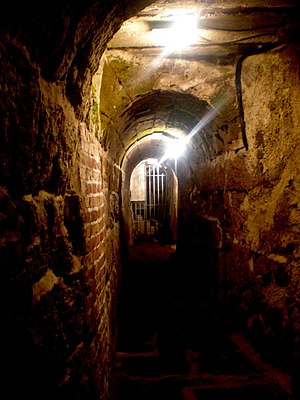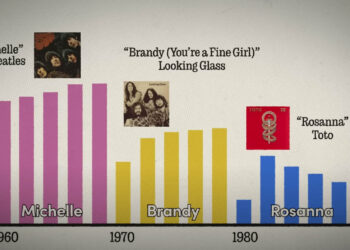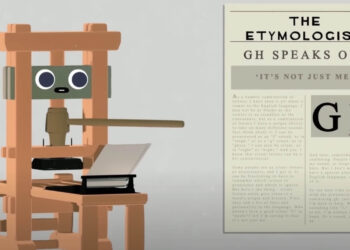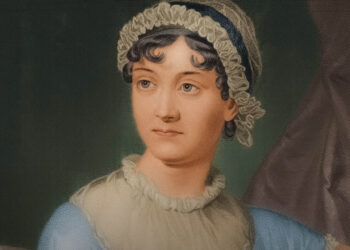
This month, with vacations on the docket, it seemed a good time to ask a question bound to get the mind thinking of faraway or unfamiliar places. And since scholarly publishing is a worldwide endeavor — all the more so with the Internet bringing authors and readers even closer — travel for information specialists has become quite interesting. So, I asked:
“What’s the strangest place you’ve been for your job?”
The answers follow, in the order received. Having read them, I can guarantee . . .
Joe Esposito: What makes something strange is what happens there. So I could nominate the time, sitting in the offices of Simon & Schuster in Rockefeller Center, when a group of Sikhs came in to negotiate a software license and placed their ceremonial swords on the conference table. Or there was the diminutive executive who jumped on top of a table at an operating review and began to scream at my boss. Ah, corporate America: how bland.
But I would have to single out the elegant restaurant in Warsaw, where I was taken by the management team of a client of mine. There were about eight of us, all in our cups. I looked around the restaurant. There was a violinist, heavy furniture, drapery everywhere. And then it hit me: now that the Communists are gone, the Poles had reverted to the cultural life of what had preceded that era; they had essentially had to erase the twentieth century.
When I mentioned this to my hosts, one of them pounded the table loudly and proclaimed: “You Americans don’t understand. You think it is all Communism and capitalism. In Poland the Austrians marched in in the eighteenth century. Then there was slaughter during the first World War, followed by a brief period of a republic. And then we got Hitler. Following him, we got Stalin. It is always this way, never Poles for Poles.”
I naturally wisecracked that “and now you have the Americans,” to which he said: “Yes! And you must understand, you must tell everybody when you get home, that we are with you. No more Germany, no more Russia. We are with the Americans forever.”
This was a bit unnerving for my typical knee-jerk left-wing outlook. The American Dream is alive and well, in a cafe in Poland.
Todd Carpenter: I was giving a keynote speech at the National Diet Library in Taiwan, and as part of my presentation I noted the first printed book wasn’t from Gutenberg, but it was published in China. Movable wood-block printing had been underway in Asia since sometime prior to the year 868 and there are some examples of wood-block prints made from as early at the turn of the 8th Century. I presented an image of the Frontispiece of the Diamond Sutra which is currently located at the British Library in London. After the presentation, the Director of the Library said that the National Diet Library had the second oldest book. He asked me if I wanted to see it? “Of course,” I responded enthusiastically. I was taken into the vaults of the Library, where I signed in under a number of Bishops, recognized scholars, and renowned politicians. They then pulled the book out of case and began flipping slowly through pages to show me the different images in the book. It was amazing to see essentially the second printed book in existence outside of a heavy glass case being held and touched like a real book should be. It’s refreshing to see books even incredibly old book used and not just as a museum piece.
Judy Luther: When Embry Riddle Aeronautical University bought Prescott College in Prescott, Arizona to establish a western campus in 1978, I was asked as their library director to go out to review the library, hire a librarian and see what was necessary to make it suitable for operation. Prescott College was very “open” for that era and the students had been able to access the library any time of day or night that they desired. The closest title in the collection that was related to flying was on archeology of dead birds. The strange part was that the library was dead. Part of the past as well as a scene from the future – where – years later Indiana Jones discovers this setting which is well preserved due to the arid conditions.
Flash forward 15 years to a library at Westinghouse Corporation in Pittsburgh, Pennsylvania that had been ‘closed’ in 1993. I was in sales to corporate libraries for the Faxon Company at the time and was shown the library that had just ‘died’. I walked through many stacks loaded with volumes of journals and books in an otherwise eerily empty facility that felt abandoned – the 5 staff no longer employed. They had focused on the collection, rather than their users, and ceased to be ‘relevant’. Meanwhile in another building nearby in a smaller space with a very dynamic staff were librarians actively engaged in working with the administration on strategic questions and supporting researchers. At the time I thought that corporate libraries were 20 years ahead of academics in needing to align themselves with the goals of the parent organization.
Sadly I wasn’t far off in my assessment as many academic libraries today are seeking to demonstrate their value to their administration. The two ‘dead’ libraries had to go in order to be replaced with a more vital model – one that had growth potential. Today Westinghouse has at least two locations with Information Analysts and Embry Riddle just added 3 degrees to the programs offered on its western campus: astronomy, cyber intelligence and cyber security. Indiana Jones – where are you now?
Rick Anderson: I’m a librarian. My job doesn’t really take me to many strange or exotic places. I travel outside the country only a couple of times a year, and almost always to the UK (which, don’t get me wrong, I absolutely love). The most unusual and intriguing place that work has taken me was Beirut, Lebanon. I went there to give a talk a year or so ago, and was immediately struck by how different everything smelled, how much more frequently people touched me in conversation, and how much trouble you could get in if you stood across the street from a government building looking at your smartphone for too long. I was intrigued by the hookahs in the restaurants, and moved by the still-fresh reminders of war that were everywhere in the city center, the shell craters in the walls and the bullet holes that still perforate the statues on Martyrs’ Square. As I walked around the city, I kept being brought up short by the call to prayer — a reedy male voice singing a gorgeous and inscrutable melody over a scratchy loudspeaker, echoing against the stucco walls in the narrow streets. I was constantly touched and impressed by the overwhelming graciousness of my hosts and colleagues, all of whom made me feel as if I had been their friend for a very long time. My fondest memory is of our last night together, when we took a bus up the coast to the 7000-year-old city of Byblos and ate an unbelievably varied and sumptuous meal of mezze and seafood at a restaurant that I can only hope I live long enough to visit again. It really did feel like a different world to me, which I suppose says more about me and my limited perspective than about Beirut itself. It was an unforgettable experience.
Kent Anderson: Even though I came up with this question, it’s hard to answer. Some places have been fascinating (the museum housing the Terra Cotta Army in Xi’an, the Christ Statue above Rio, a strange restaurant/winery/bomb shelter in Frankfurt, the basements of various libraries, a loft containing 16th-century books), some scary (a chicken sushi bar in Tokyo). But the strangest memory has to be one of my first “customer focused” visits, which I initiated as a new Managing Editor over a burgeoning list of emergency medicine publications. I lived in Atlanta at the time, and Grady Memorial was the major emergent care center of the city, so we worked some connections and arranged to visit the ED (they don’t like being called ERs). The goals was for us as editors and publishers to gain a better sense of how these people worked and what information they needed. Well, imagine four preppy suburban editors walking into an inner-city ED. We stood out, to say the least. It was crowded, hot, and noisy. But the emergency physician who took us on the tour was nonplussed, so much so that when a gunshot victim was wheeled by with an ambu-bag being worked over his nose and mouth, and they had trouble fitting both the orderlies and the gurney through the door simultaneously, our tour guide nonchalantly took over pumping the ambu-bag while the orderlies worked things out, all the while chatting with us. Bloody bandages were visible. It was clear that our sterile little information world was far from the reality of emergency medicine — and this was part of why it was valued. It turns out that making sense and learning requires a step of remove from reality, a zone of contemplation and clarity. A few weeks after this, the Atlanta Olympics started, and soon after, the bombings embroiled Grady in a nightmare of emergency medicine. We covered it as local press, and the emergency physicians were again amazing. Once again, journalism and publishing played a role in making sense of a situation, connecting disparate pieces into a narrative. The timing, the visceral memories, the events, and the people made me realize profoundly how important our audience is to human well-being. Strange? Yes. But also, very motivating.
David Crotty: My various jobs as a researcher, editor and now publisher have brought me to a lot of strange places. I once spent a week in a converted hangar on a runway at Cape Canaveral getting fish to mate in order to put their eggs on the Space Shuttle. I recall ducking out of a conference in Madison, WI, to visit both Taliesen and The House on the Rock, seeing both ends of the cultural spectrum in one wonderful day. The bowling alley in the basement of the White House was quite memorable, as was the situation room at the CDC.
But without a doubt, the strangest place my job has ever taken me was the year the Special Libraries Association held their annual meeting in Denver, and the hotel where I stayed was also hosting The Rocky Mountain Fur Convention. No, this was not a conference about mink coats. The librarians were great. The furries? Well, I’ve tried to blank out as much of that trip as possible . . .
Tim Vines: My strangest place/situation was getting lost during a biodiversity survey in a remote part of the Peruvian Amazon. I was with an ornithologist, and we were trying to find a bird hide in the middle of a swamp. We had somehow wandered off the trail (a series of muddy puddles) and were thoroughly clueless about where we were. We had compasses but we didn’t know where we were in relation to the lodge, so they weren’t much use. Once it started to get dark, we realised we might have a problem. Fortunately, the ornithologist knew his stuff, and since the swamp was surrounded by bamboo thickets, he started listening for bird calls from bamboo specialist birds. After a few minutes, he picked out the call of a Manu Antbird, and sure enough some wading and clambering saw us back on dry land and on our way back to the lodge.
David Smith: So there I was, standing in a field in a remote farming village 50 miles northwest of New Dehli, India. No mains water. No mains power. Access via a very bumpy dirt road. On the road next to me was this cow. If you’ve looked at any images of rural India, you’ll have an idea of what this cow looked like. Not a plump western beast, all supplements and whatnot. No. Skinny, big horns, shackled to a cart on which were loaded various farming supplies. I had my camera with me, and it was just a perfect picture. I looked at the cow. The cow looked at me. I raised my camera up, focused, and took a picture. Click. Not a big sound, but apparently, just the most terrifying thing that this cow had ever heard. It emitted a bellow, executed a magnificently rapid three-point tur,n and shot off down the road with its owner screaming and yelling at it whilst his buddies burst out laughing and I looked for a hole to swallow me up.
A short while later, whilst drinking milky sweet tea, we discussed (through an interpreter) how we might get useful information to the farmers to help them improve the yield on their crops and rescue crops under attack from pests and diseases. Some of the farmers were illiterate. But they all had mobile phones. Despite the remote location, there was a decent 3G signal, and a few miles away, we could see a cell phone tower through the haze. India is connected for the mobile revolution. One of the farmers showed us a field of mustard that he had managed to double the yield on due to some of the information CABI had supplied to a local mobile phone company to broadcast on with text and voice messages. Not everything needs a state-of-the-art smart phone. It brought it home to me, we are in the information supply business, and many times, supplying that information is not easy or straightforward. Clay Shirky, I got news for you — it’s not just a button, not out here. Here, we converted scholarly information into a local dialect voice message at an appropriate level for an illiterate farmer so that he and his family could be better off. Here is where the mobile revolution is happening, off the grid, in remote fields all over the world. The farmers’ kids are literate. They’ll grow up with an understanding that you can get actionable knowledge from a device that’s always with you, ready whenever you need it. And if we do our stuff right, they’ll be better off than their parents are. And that is just the most awesome thing to think about. If you want to know more about what we’ve been up to at CABI, and where we want to go next, visit http://www.plantwise.org.
David Wojick: My strangest place was being put into a small cage and lowered down a 900′ shaft to verify that it was really there, which everyone already knew. Technically it was the closeout inspection for a federal construction project. The contract called for an inspection, and simply looking down from the top, at the tiny people at the bottom, was deemed inadequate.
The connection to scholarly publishing is that much of the published research is federally funded, and contracting requirements can get pretty strange. Many of the nebulous reforms presently being called for can only be implemented through new contract clauses. Thinking about what these new requirements might lead to soon reveals a deep hole of unintended consequences.
For example, I was recently involved in a discussion where it was proposed that anyone ought to be able to demand to audit all of a scientists work that led to a given journal article. This means to audit in the IRS sense, checking and challenging every step, not just sitting in on it, as one might audit a class. This insanity was couched in the honorific terms of transparency and replication. But it clearly has the potential to grind science to a halt, or at the very least deter formal publication. In the regulatory realm this is called avoidance. That is a hole we do not want science in. So I have developed a nasty habit. When I hear one of these proposals for “fixing science” I ask about the specific contract language. Then we have something to talk about. Otherwise, I think of once again going down that 900′ shaft.
Discussion
5 Thoughts on "Ask the Chefs: "What's the Strangest Place You've Been for Your Job?""
Everyone in Atlanta knows that if you have been shot, stabbed, or in a gnarly car crash, Grady will fix you up like some sort of Frankenstein flick. If you are having a heart attack and aren’t visibly bleeding, you better go to Emory.
As a young book production person, I thought Crawfordsville, Indiana, was the strangest place I could possibly go. I was there for a press check that lasted 36 hours and barely left the plant. But what I did see was an Applebees and a drive through. That’s it.
This was strange to an east coast suburbs kind of girl. But stranger was the Town and Country resort in San Diego. Do NOT go there.
Press checks are notoriously weird. One in Minnesota amounted to me sitting in a suite inside the printing plant for nearly an entire day while enjoying snacks and beverages, reading a book, and waiting for the knock on the door announcing new signatures to review. So exciting!
The Town and Country in San Diego is something I haven’t enjoyed personally, but one that people I work with still groan about. The pictures and stories they shared were rather vivid.
Whoa! The San Diego town and Country resort! Went there for a conference once. There was a Santa Ana? wind – unusually cold air coming down from the mountains. We were all dressed for the more typical San Diego climate. Myself and a colleague got lost in the place. An hour later and very, very cold we finally made it back to the main entrance area and were able to retrace our steps. That place is seriously weird.
The most unusual experience for me, and I have several, was being accidentally locked in the basement of the Louvre. We were holding a conference at the Louvre Conference Center. We stayed late to prepare the conference room and accidentally stayed after the closing. All of the public exit doors were locked and there was no one to help us find a way out. After wandering around aimlessly for a while, we inadvertently exited the conference area through a door to the Louvre storage basement. We meandered through the storage area for some time before we found a door which (we hoped) lead to the outside. We opened the door and found ourselves in the Rue des Pyramid tunnel under the Tuileries Garden. Our exit through this door did, of course, set off the security alarms at the Louvre.
The field library for the Air Force Survival Training School comes to mind. A Thai boxing lesson just north of Bangkok also rates, as does the eel feeding ceremony in Melbourne. Valentine’s Day at Vancouver Island University in Nanaimo felt far away, but was memorable because the students outside the library gave out free cookies and cakes, letting me know there was no charge for kindness.



